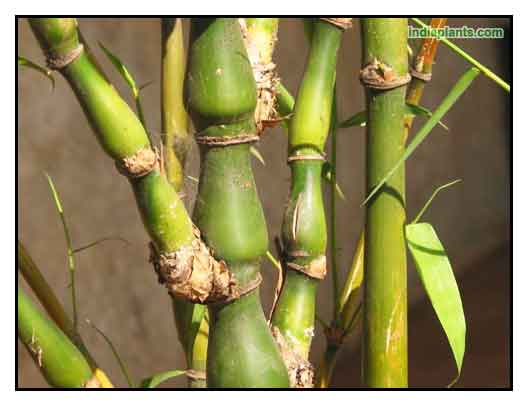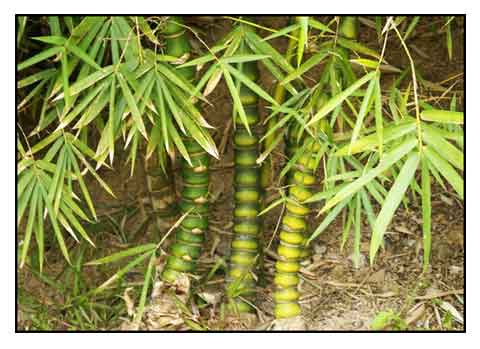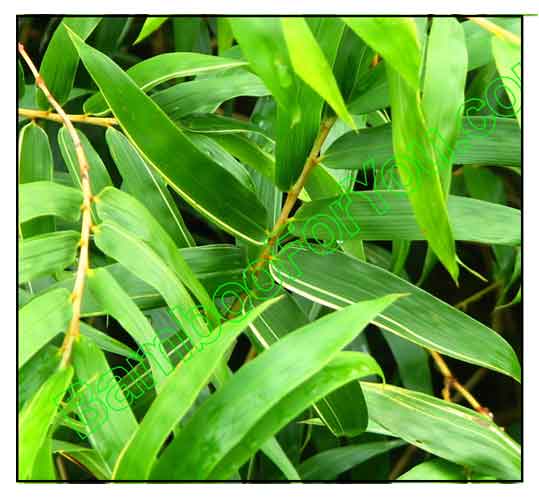 Gen info Gen info
- Bamboo refers to a group of plants in the subfamily Bambusoideae, part of the true grass family. The subfamily contains more than 70 genera and about 1,450 species. (4)
- Bamboo is a plant is amazing versatility with utility in the minutiae of day-to-day life.
-
Bambusa tuldoides is cultivated as an ornamental. When cultivated in pots, the plant remain small forming swollen internodes, earning the name "Buddha's belly bamboo" and much treasured in the bonsai and horticulture circles. (3)
- Bamboo is a crop that does not require pesticides and has no history of plagues propagation. like soy, wheat, sugar cane crops. (5)
- It is an economically viable crop due to its perennial and asexual culms, without need of replanting. (5)
- It has sustainable extraction and the plantation can last for more than 100 years.(5)
Botany
Bambusa tuldoides is a densely tufted sympodial bamboo. Culm is erect with slightly nodding tip, 6 to 10 meters tall, 3 to 5 centimeters in diameter near the base. Wall is 4 to 5 millimeters thick, glabrous, thinly covered with a white wax when young; internodes 30 to36 centimeters long, not swollen, lowermost 1 to 2 nodes with a ring of grayish silky hairs above the sheath scar. Branches occur frequently from the basal 1st and 2nd node upwards, branch complement few to many, with the primary branch dominant and thornless. Culm sheath is caducous, glabrous or sparsely covered with a few deciduous appressed brown hairs on the outer surface, marked with 1 to 3 yellowish strips towards outer margin, ribbed striated when dried, the apex asymmetrically triangular to narrowly triandular, acuminate and subulate, the base 3/4 as wide as the apex of the sheath, the basal margins adnate to the auricles, blabrous or sparsely covered with a few deciduous appressed brown hairs on the outer surface rough hairy on the lower half of the inner surface; ligule 3 to 4 millimeters long, laciniate and shortly and densely fringed; auricles prominent with slender bristles along the edge, slightly unequal.. Young shoots glabours. Leaf blade lanceolate to narrowly lanceolate, 10 to 18 by 1 to 2 centimeters, glabous or sparsely pubescent toward the base above, densely soft hairy beneath. Inflorescence borne on long leafless branches, consisting of pseudo-spikelets, scattered along the branches; spikelet 2 to 5 centieters by 2 to 3 millimeters, greenish yellow or with a purple hue, with 2 to 5 perfect florets. Caryopsis terete, slightly curved, 8 millimeters by 1.5 millimeters, thickened and hairy at the apex. (Pl@ntUse) (3)
 Distribution Distribution
- Introduced.
-
Ornamental cultivation, often as a hedge.
Constituents
- In a physiochemical composition, flour presented with a moisture value inferior to 10 g/100g, expected due to drying process.
- Chemical composition of young bamboo culm flours yielded (g/100g)
nutrients for bottom, middle, and top parts: moisture 3.2, 3.34, 3.19; protein 1.57, 1.43,, 1.72; lipid 0.12, 0.20, 0.39; and ash 0.80, 0.94, 2.38, respectively. On carbohydrate analysis, total sugar 1.29, 1.47, 0.94; total starch 2.23, 2.65, 1.75; total fiber 89.46, 90.21, 86.21, insoluble fiber 89.79, 87.97, 82.91, respectively. The culms show lowest sugar content, which suggests more stability with processing, both for flour production and fiber and starch extraction, with more storage time. (5)
- Study of95% ethanol extracts using HPLC/UV characterized four diastereoisomers, oxyneolignans A, B, C, and D, each occurring as a pair of enantiomers. (6)
- Phytochemical screening of leaves of Bambusa ventricosa yielded tannins and polyphenols +, saponins +,
general glycosides ++, cyanogenic glycosides +, flavonoids +, coumarins +, with absence of alkaloids, carotenoids, triterpenoids and steroids, anthraquinones, anthracene glycosdes. (7)
Properties
- Studies have suggest anti-fatigue and antibacterial properties.
Parts used
Leaves, shoots.
Uses
Edibility
- Young shoots are edible; bitter, creamy and tender when cooked.
Folkloric
- In Chinese medicine, shavings of culm cortex (chuk yu) used for febrile diseases, hematuria, epistaxis and infantile epilepsy. (3) In traditional Chinese medicine, it is considered cooling, calming, and phlegm resolving, used in many formulas to treat lung and stomach heat, and correct up-flowing qi. (2)
- In Africa, traditionally used in the treatment of various types of fever. The extraction is made by cooking fresh bamboo leaves using fermented cereal grain steep liquor made from maize and sorghum. (2)
Others
- Tools: The culms are used as farm implements, as punting tools and scaffolding.(3)
- Crafts and construction: Splits are used in weaving utensils and handicrafts. (3) Used for making hats, chairs, tables, exterior and inner hut walls, kalatongs, chopsticks, drinking utensils, table mats, beds, hammocks, wooden "piggy" banks, slippers, bags and baskets, etc.
S tudies tudies
• Anti-Fatigue Effect / Stem Shavings: Study of an extract of stem shavings of Bambusa tuldoides (250 mg/kbw/day) showed an anti-fatigue effect in mice as evidenced by prolongation in duration of weight-loaded swimming and climbing, along with increase in hepatic glycogen content, and decreased serum urea nitrogen and lactic acid levels (Zhang et al, 2006). (2)
• Antibacterial Effect / Leaves: Study evaluated the antibacterial activity of different fermented ceral (Zea mays and Sorghum bicolor) grains steep liquors as extraction medium for bamboo leaf. The extracted leaves were screened for inhibition of some pathogenic species i.e., S. aureus, S. typhi, S. faecalis and E. coli. Fresh leaf extracts at concentration of 20 g/100 ml showed antibacterial activity against all tested bacteria, while the ethanolic leaf extract did not show activity against S. typhi and S. faecalis. Yellow maize liquor exhibited greater antibacterial activity in comparison to others. (4)
Availability
- Wild-crafted.
- Ornamental cultivation.
- Tinctures, dried shaving powder liquid extracts in the cybermarket. |

![]()



 Gen info
Gen info Distribution
Distribution tudies
tudies 